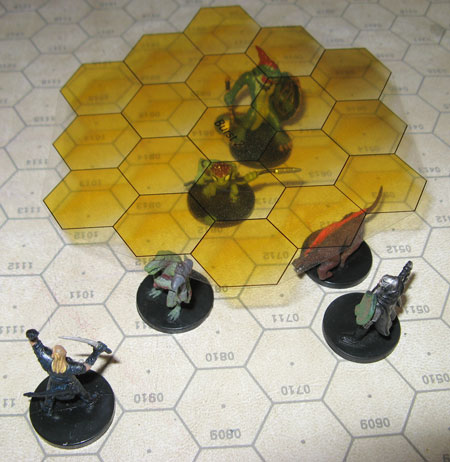I didn't want to reduce the count for bursts, but I couldn't find any good way to preserve it while keeping a symmetrical shape. Blasts were easier to keep the count on because of the shape I chose, based on a cone. Having the two not match in size wasn't an ideal solution.
So I kept bursts hexagonal, and they do cover less area than their square counterparts. It is somewhat balanced by there being fewer hexes adjacent to a character (6 rather than 8), and by blasts being close. Blasts have a slightly bigger area, but you have to be right there to deliver the spell most of the time.
Making the templates circular is another option for bursts. That's what we did with fireball and the like in 3E (we still used a hex grid), but then again, the spell description said it was a 20' radius circle. What is the diameter of a square spell? (that sounds like a philosophical question, like what is the sound of one hand clapping?). How big do I make a burst one spell if I make it circular? Certainly a number could be chosen that covers about the right number of hexes, but it would involve partial hexes at the edges.
I like knowing which hexes are targeted by the spell, and we have fewer "edge" cases with the hex templates than we did with the round one in 3E. Ultimately I felt clearly showing which hexes were affected was worth the tradeoff, but I could see using pipe cleaners to make a circle of the right size and just dropping it over the enemies.
I could have made the blasts follow suit and made them hexagonal with the same count as burst spells. That certainly would follow the standard rules more closely. I wanted blast spells to be cones, because D&D has always had round spells, and cone-shaped spells. At first I tried a 60 degree arc, but it was a bit odd as far as fitting it onto the hex grid. It wound up really narrow, and to cover enough hexes it needed to be wider. So I went with 90 degrees.
Your suggestion of just making an arc-shaped template covering 60 or 90 degrees is good - pivot it around and adjudicate edge cases as with the round template. Just decide how much area it should cover.
I suppose it just depends on how you like to play. I'm not sure my group even knows that these spells are all square in the default rules, because they've virtually never played on a square grid. These templates are used by the bad guys as well, so all spells in the game work the same way, even if it's not exactly RAW. It works for us.






